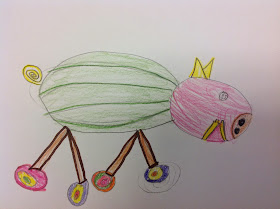After stumbling upon so many Pinterest projects and hearing about Zentangles from my colleagues, I had to give it a try once this year. I decided to incorporate it into this project as the boarder of the mounted print. Turns out, didn't work so hot on this project! I think it was too simple of a space and not the right kind of space to do it in. (I'm still learning about Zentangles too!) Still really love the printing part of this project, so did the students, and I will think of something different for the background/boarder for next year.
I CAN statements for the Zentangle portion:
WE CAN think of and create examples of as many Zentangle designs as possible
I CAN create a boarder for my mono-print portrait using Zentagles
I CAN statement for prints:
I CAN create a self-portrait mono-print using warm or cool colors
Day 1: Started by showing them what our final product would look like and then told them we were going to focus on the Zentangle boarder portion of it first and do the prints next time. I gave them some background knowledge of Zentangles and how they started, as well as the popularity of them. I also showed them a few examples of artwork created with Zentangles. We talked about the qualities in the lines and different characteristics of the designs and I gave them a stack of post-its and ultra-fine tip sharpie and let them loose to think of as many designs as they could for a foundation to start the project with. As they completed them they stuck them to a cabinet in the classroom to serve as our "bank" of designs for reference when starting the boarders.
After about 15 minutes they were allowed to start on the project or continue with post-its. I encouraged them not to use a ruler for measuring the boarder to keep designs looking more natural and explained that when they attached the print it would square off the designs. This REALLY stressed out some kiddos but we worked through it and/or they ultimately used a ruler.While they were working, we took a picture of each student to use for the mono-prints. Before the next class we printed the pictures of the kids in black and white full page to use under the printing plastic as the guide for prints.
After about 15 minutes they were allowed to start on the project or continue with post-its. I encouraged them not to use a ruler for measuring the boarder to keep designs looking more natural and explained that when they attached the print it would square off the designs. This REALLY stressed out some kiddos but we worked through it and/or they ultimately used a ruler.While they were working, we took a picture of each student to use for the mono-prints. Before the next class we printed the pictures of the kids in black and white full page to use under the printing plastic as the guide for prints.
Day 2: I had the word mono-print written on the board and we dissected the word and using the background knowledge of looking at my example, I had them figure out how it was created and what a mono-print was. After a good discussion we watched my demo. Now this is absolutely my favorite thing I did for this project... The day the first class was going to print, I had my assistant take a video of me, before school, using my iPad, creating the print without either of us talking. THEN when it came time to demo we watched the video as a class and while watching I explained what I was doing and went through it two times because I did a warm and cool color print. This went AWESOME. I think this worked SO WELL because I do not have a great spot to demo things so usually people can't see or they don't pay attention and talk... I will for sure be using this concept of recording my demos again in the future.
When it was time to print, they printed in small groups with me while others worked on their boarders and there was almost zero questions about the process. They slid their picture under a plastic sheet and painted over it with tempera paint (not watered down) quickly without washing the brushes in between colors (i.e. why warm and cool color sets were used). They did two prints so they could chose their strongest for their final product.
When it was time to print, they printed in small groups with me while others worked on their boarders and there was almost zero questions about the process. They slid their picture under a plastic sheet and painted over it with tempera paint (not watered down) quickly without washing the brushes in between colors (i.e. why warm and cool color sets were used). They did two prints so they could chose their strongest for their final product.
Day 3: Small review on mono-prints, re-watched demo for those who had to print this day, and then finished up printing. Almost all classes finished in 1 or 2 days. When prints were dry and boarder complete, they used a glue stick to attach the print they liked better to the boarder paper.
Pretty amazed how much some of these look just like them!
For one of my classes we were working on this right up to the last days of school...the last day of Art got a little silly and a student used their extra print and a silly project they did with a sub to make this ridiculously awesome artwork. LOVE.
I'm curious, how do you use Zentangles? Was I even in the right ball park?































































